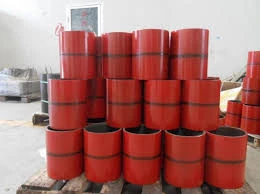Understanding Well Tubing and Casing in Oil and Gas Extraction Processes
Understanding Well Tubing and Casing in Oil and Gas Operations
In the oil and gas industry, well tubing and casing are essential components that play crucial roles in the extraction and management of hydrocarbons. These elements ensure the structural integrity of the well, protect the surrounding environment, and facilitate the efficient flow of oil or gas. This article delves into the definitions, functions, and distinctions between well tubing and casing, highlighting their importance in drilling operations.
What is Well Casing?
Well casing is a series of pipes that are inserted into a drilled borehole to provide structural support and prevent the collapse of the well. It serves to isolate various underground layers and protect groundwater resources from contamination. Typically made of steel or PVC, casing comes in various diameters and is installed at different depths depending on the geology and requirements of the well.
The casing process usually involves three key stages the surface casing, production casing, and sometimes intermediate casing. The surface casing is the first level of casing set into the well and extends to just below the water table to protect freshwater layers. The production casing, on the other hand, is set deeper and allows for the production of hydrocarbons from the reservoir.
Casing also plays an essential role in managing pressure within the well. By creating a sealed environment, it helps to prevent blowouts—uncontrolled releases of oil or gas from the well that can have disastrous consequences for both safety and the environment.
What is Well Tubing?
Once the casing is established and the well is ready for production, the next step is the installation of well tubing. Tubing is a smaller diameter pipe inserted through the casing to transport the oil or gas to the surface after extraction. Unlike casing, which remains in place for the life of the well and is essential for well integrity, tubing can be removed and replaced as needed for maintenance or during workover operations.
well tubing and casing

Well tubing is frequently made of high-strength steel and is carefully designed to withstand the pressures, temperatures, and corrosive environments encountered during production. Optimal tubing performance is critical for ensuring that hydrocarbons flow efficiently from the reservoir to the surface.
The Distinction Between Casing and Tubing
While both casing and tubing are vital to the functionality of a well, they have distinct roles and characteristics. Casing provides structural support to the wellbore and seals off extraneous geological layers, while tubing is responsible for the transportation of produced fluids to the surface.
Another significant distinction is that casing is a permanent installation designed to remain in place for the well's entire lifecycle. In contrast, tubing is often composed of modules that can be replaced or serviced, thus allowing for more flexibility in production management.
The Importance of Proper Installation and Maintenance
The installation and maintenance of both tubing and casing are critical for the success of drilling operations. Poorly installed casing can lead to well integrity issues, which may result in costly repairs, reduced production levels, or, in worse cases, environmental disasters. Regular inspections, routine maintenance, and adherence to industry standards are essential in ensuring that both tubing and casing perform as intended throughout the lifecycle of the well.
Conclusion
In summary, well tubing and casing are indispensable components of oil and gas drilling operations, each fulfilling unique functions that contribute to the overall success and safety of hydrocarbon extraction. Understanding their roles not only helps industry professionals optimize production but also ensures the protection of the environment and public health. With proper design, installation, and maintenance practices, the oil and gas industry can continue to operate efficiently and responsibly in the challenging environments in which it operates.
-
Tubing Crossover - API Compatible, Custom Sizes, In StockNewsNov.10,2025
-
Tubing Coupling | High-Strength, Leak-Proof Steel CouplingsNewsNov.10,2025
-
Wholesale API Threading Casing Coupling | API 5CT, Fast ShipNewsNov.10,2025
-
Pup Joint Supplier | API Certified, Custom, Quick ShipNewsNov.10,2025
-
Pup Joint Manufacturers | Precision Machined, Fast DeliveryNewsNov.10,2025
-
Tubing Coupling | Precision Steel, Leak-Proof, Fast DeliveryNewsNov.03,2025







